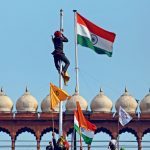Tridip Suhrud is a social scientist from Ahmedabad
Swaraj is a call, a concept, an endeavour, a dedication and a dream. Ever since Dadabhai Naoroji used the term swaraj to articulate the nature of aspirations of the Indian people, no other term has equalled its resonance. Its appeal and reach were almost immediate and universal. There were other terms which were available; some, like azadi, were equally evocative. But, azadi and swatantrata referred specifically to the political realm. They assumed a state of slavery or foreign rule, without which the idea of freedom is philosophically untenable. Orlando Patterson, in his 1991 classic Freedom in the Making of Western Culture, traced the genealogy of freedom. Freedom is one of the most cherished values of our times, in the West and elsewhere. He links the birth of freedom to the institution of slavery. Swaraj is grounded in freedom, but its meaning is not exhausted by this aspiration. This term is constituted by two elements: swa (self) and raj (rule). Swaraj, therefore, alludes to two possible meanings: ‘rule by the self’ and ‘rule over the self’. Rule by the self refers to a political aspiration; it deals with aspects of sovereignty. Rule over the self opens up the meaning to include the personal, the normative and the moral. Swaraj thus links the personal with the societal and moral, with the political.
Ananya Vajpeyi’s book Righteous Republic seeks to trace the intellectual and political ligature of the idea of swaraj. She does this by attempting to answer a large question. What is the nature of swa, or self, that swaraj refers to? Or, more politically, what is this self whose sovereignty is sought to be reinstated? These questions and her reading of swaraj are intrinsic to the national movement. She does this by an inquiry into the intellectual foundations of the five founding figures of our republic: MK Gandhi, Rabindranath Tagore, Abanindranath Tagore, Jawaharlal Nehru and BR Ambedkar. She locates in Gandhi a search for ahimsa; in the poet Tagore a longing (viraha) and in the painter an aesthetic experience (samveg); in Nehru artha (meaning) and dharma, while in Ambedkar suffering (dukkha) as the principle orientations by which they sought to understand the nature of swa. These, she argues, are five possible orientations of self: self is understood and grasped, in its orientation to others, in its longing, in its capacity to experience aesthetic ‘shock’, in its aspirations and purpose, and in the burden of the self.
This work is not about an idea of India, although it could be read that way. It is not propelled by the anxieties—whether misplaced or genuine—about the rise of Hindu politics. Righteous Republic is concerned with the quest for virtue. It seeks to relocate the moral within the political. It is a powerful reminder about the nature of the moral quest that provided the foundation for the national movement, with all its plurality and polyphony. Let us take an example, the most obvious one of MK Gandhi. In his 1909 philosophical text Hind Swaraj, he asked the very same question: ‘What is swaraj?’ His answer was simple and yet difficult to practise: ‘It is swaraj when we learn to rule ourselves.’ Gandhi’s ‘rule ourselves’ necessitates self-knowledge or self-recognition. For him, civilisation—or to use the frame that Righteous Republic uses, the tradition by which conceptions of self emerged—is that mode of conduct which leads one to the path of duty, wherein performance of duty means observance of morality.
Morality, Gandhi says, “is to attain mastery over our minds and passions. So doing, we know ourselves.” For him, swaraj is not possible in the absence of self-knowing, which requires observances of the moral kind. Gandhi’s observances, his experiments with truth, his khadi, spinning, prayer, fast, silence and above all brahmacharya (abstinence) were his attempts at ruling himself, thereby creating the possibility of swaraj. But, as Righteous Republic once again shows, this idea of the moral self was not the only orientation that was available to us. Ambedkar argued that Gandhi’s ahimsa had less than equal space for suffering, for dukkha. The poet Tagore acted as a Great Sentinel [Guru Dev]—as Gandhi called him—and challenged the meaning and efficacy of Gandhi’s fasts. Thus the norm of righteousness for us emerges from this dialogue that the founding figures had with each other, with our past and its intellectual and philosophical traditions.
It is possible and profitable to read the book in other ways. Just as a work oriented towards visions of possible futures often tends to be a fable for the present, a work in history sometimes provides a ground to re-engage with the present in newer ways. Today, in our social and political lives, these figures have become lesser persons, at times parochial, proprietary and almost always divisive. They are thought to be more in opposition to each other rather than in congruence. We practise our politics such that it becomes imperative to speak of Gandhi versus Ambedkar, or of Nehru’s opposition to Hind Swaraj. Undeniably they differed from each other, almost always in public, often in acrimony but, in most instances, their differences were articulated with extreme courtesy. These differences were rarely tactical, they were moral. Even issues that appeared as contingent upon the present were informed by civilisational concerns. The opposition of Tagore to the ‘Cult of the Charkha’, as he called it, was neither about its symbolic significance nor its efficacy as instrumental in obtaining swaraj. It was about the limits to human creativity that the daily, repetitive act of spinning could entail. It was Ambedkar who reminded Gandhi about the difference between empathy and suffering, between suffering that is sought as an act of self-volition and hence sublimating, and suffering and humiliation that is the human condition itself. Gandhi, bereft of Tagore and Ambedkar, would have had less transformative potential. Despite the pleas of intellectuals like DR Nagraj, to imagine a political scenario that brings the transformative potentials of Gandhi and Ambedkar together, we feel more secure in their assumed incompatibility.
We need to ask what happened to this moral imagination. Was this striving so fraught that it is no longer available to us? Were there other potentialities in our society that have become dominant instead? Or more fundamentally, do we no longer need moral strivings? The question of potentialities is easier to answer. Ashis Nandy, in his ‘prayer speech’ at the Sabarmati Ashram on 30 January 2008, spoke of Gandhi as a potentiality, as a force within us and not as a person who lived in history. He reminded us that while the Pathans were later depicted as being fanatical about violence, they were at one time (under the guidance of Badshah Khan and Gandhi) as fanatical about non-violence. Societies and cultures are not closed systems. The role of moral imagination is to keep the choice open, allow various contending potentialities to be tempered so that the possibility of right conduct remains available at all times.
And yet, the trajectory of post-Independence India suggests that we were—in some fundamental ways—not willing or able to grasp the opportunities that the freedom movement and the Constitution provided us with. One possible reason for this is the emphasis on the political, where realpolitik is seen not only as a primary mode of negotiating social relations, but as a sufficient mode that contains and exhausts all other possibilities. It is one thing to concede that economic, cultural and social relations are constitutive of relations of power in a society, but it is quite another to seek their resolution exclusively in the domain of electoral politics. Electoral politics can capture the will of the people, but that is no guarantee that the electoral choice is also a moral choice.
The second reason for our lack of moral innovativeness is our reliance on the juridical process as a mode of resolving non-juridical and in some ways non-justiciable issues. Our judiciary has shown innovativeness and made attempts to carve an autonomous space for itself. Increasingly, we have come to rely upon the legal process to resolve our moral dilemmas. Mass violence is a case in point. Violence has acquired a new salience. We turn against ourselves with ferocious regularity, revelling in the macabre dance of violence. We celebrate macho forms in politics, with our male and female leaders routinely brandishing swords in political gatherings. We speak of revenge and retribution restoring our cultural manhood. We are faced with a situation where violence is committed in the name of the State (or through its agency), where violence can be committed by those acting as defenders of faith, where those seeking rights and justice also use violence. And yet, we long for ahimsa. We recognise that neither justice nor equality can be obtained through exclusive reliance upon violence.
The preferred response to mass violence is a commission of inquiry, which is a creation of statutes, not of moral imagination. These commissions are a mode of governance. They help create a veneer of impartiality, allow other societal or political processes to continue unhampered and provide a feeble hope that the truth will emerge. These efforts are marked by a deep moral vacuum. By its very constitution, the procedural takes precedence over the ethical. In fact, they aid the perpetrators by delaying both legal and moral accountability. They provide no succour to the victim. And, most significantly, they have no response to the salience of violence.
The question is not just about the anomic violence. It is about our inability to create a viable space for ahimsa in our collective endeavour. One principle reason for this is that we have delegitimised the moral question. Our political parties, our State, have seceded from the moral realm. We no longer speak in terms of moral superiority and desirability of non-violence over violence, but in terms of efficacy of instrumentality. For Gandhi and Tagore, ahimsa was not an instrumentality or a constitutional legality. It was an orientation of the self towards oneself and also the other. This was a moral orientation. Their life-long endeavour was to establish the illegitimacy of violence, despite the overwhelming temptation towards violence. They argued that those who resort to violence recede from the self. Those who recede from the self become incapable of obtaining swaraj.
The third process is marked by a deep suspicion of the religious idiom in certain sections of our polity, civil society, intellectuals and public culture. We would like a separation between the religious realm and the modes by which public will is expressed. This suspicion and unease is not unfounded, especially in a subcontinent that was partitioned because of the politics of religious identity, where brutal violence is perpetrated in the name of religion, where religious idiom provides justification for suppression of caste groups, and where patriarchy seeks and finds legitimacy through religious idiom and our polity is divided on the nature of the secular.
But this suspicion has also not allowed us to engage with the question of morality and virtue. This is not to suggest that the moral cannot be or should not be imagined outside the realm of religion. And yet, it is necessary to engage with the possibilities that religiosity provides. The founders of the moral imagination of our republic, save Nehru, had a deep religious sensibility. And it was their faith that allowed them to pose fundamental questions to religious texts and traditions. They were able to access the moral realm of religious experience without ever surrendering their critical judgment. What we get instead is a fractured moral imagination, incapable of letting us think creatively about the place of virtue in politics. In the absence of contemplation on right conduct, or on ethics, we cannot face the challenges that face our republic and society today.
About The Author
Tridip Suhrud is India’s foremost Gandhi scholar and the translator of the diaries of Manu Gandhi, the Mahatma’s grandniece
/wp-content/uploads/2015/11/ll-congress.jpg)

/wp-content/uploads/2025/04/Cover-Rashmika-New.jpg)












More Columns
India received a heads up from US on tariffs Rajeev Deshpande
Saving Farmers from the Unions Siddharth Singh
The New Hotspot Kaveree Bamzai